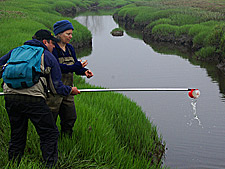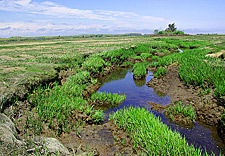For centuries now, the salt marshes along the U.S. coast have been disappearing, with some experts estimating that 70 percent have been lost, largely due to development. While in recent decades the U.S. has done a better job of protecting these ecosystems, even marshes spared from development are now succumbing to more subtle threats, from rising sea levels to invasive species.

One factor scientists always thought marshes could withstand was nutrient enrichment, such as the flow of nitrogen and phosphorus from fertilizers and septic systems. But that might not be so, warns Linda Deegan, a senior scientist at the Marine Biological Laboratory in Woods Hole, Mass., and lead researcher of a long-term study showing that an overabundance of nutrients may be contributing to the demise of salt marshes. During the nine-year study, in which Deegan’s team added nutrients to a Massachusetts estuary, the researchers found that a burst of growth eventually caused the salt marsh plants to collapse onto themselves, converting healthy systems into mud flats.
In an interview with Yale Environment 360 Web editor Kevin Dennehy, Deegan describes the implications of this study, the vital services lost when marshes disappear — from nourishing marine species to providing a physical barrier for coastal communities during storms such as Hurricane Sandy — and what it will take to prevent further marshland loss.
“What Sandy brought home is that trying to draw a line and say, ‘From here on back is human lands, and from here forward is the natural system,’ isn’t going to work,” Deegan said.
Yale Environment 360: For years we’ve heard that coastal salt marshes worldwide — and along the U.S. East Coast in particular — are disappearing. Just what kind of losses have we seen?
Linda Deegan: It’s highly variable. You know, in Boston, all of the Back Bay is built on salt marsh. There, they probably lost 80 percent of their salt marshes. You get down to Georgia and there was very little building on salt marshes.
In some areas, where coastal development was very heavy early on, we dredged and filled and built upon a lot of salt marshes. And it’s been said in some places that we lost 50, 60, 70 percent of all salt marshes. But even since we’ve been protecting them, there’s been this continued erosion and loss of salt marsh, most intensely in areas that are heavily developed.
e360: In what areas have these losses been most pronounced?
Deegan: Marsh loss in the last few decades has been most focused from Cape Cod through the mid-Atlantic. And if you skip over to Louisiana, there’s been a lot of marsh loss in the Mississippi River Delta.
e360: And does that still largely correspond with areas where development is greatest?
Deegan: Along the Atlantic seaboard, absolutely. But I think marshes are being hit by a number of different stressors at this point. There’s nutrient pollution. There are changes in the biotic community, there’s sea level rise. All of those are probably acting synergistically to affect salt marshes.
“Marshes do take up a lot of nutrients. The question is what happens after they take up those nutrients.”
We used to think that just about the only thing that bothered a salt marsh was sea level rise, and that other kinds of changes in the environment they went through they were either immune to or helped ameliorate. Like nutrient-loading. Our original thinking about marshes was that they could take nutrients out of the water and thereby buffer and protect the rest of the ecosystem. And there’s absolutely truth to that — marshes do take up a lot of nutrients. The question is what happens after they take up those nutrients.
e360: Which is the question at the heart of your study on Plum Island in Massachusetts. Could you talk about the study and what you were looking to find?
Deegan: Our original question was how marshes respond to this general broad, increase of nutrients in the coastal area. How does it change food webs? How does it change plant and animal production? We were also interested in trying to understand what were the limits to the “buffering capacity” of marshes. We thought there had to be some sort of limits, but we didn’t really know what it was”¦
And so we wanted to emulate as best we could on Plum Island how marshes receive nutrients coming from the uplands in developed areas.
e360: Typically this nutrient loading is from fertilizer and sewage and septic systems?
Deegan: Yes, exactly. The upland nutrients come from sewage, septic, fertilizer for lawns, for agriculture, those kinds of things. And the nutrients that dominate that flow are called nitrates, which is a form of nitrogen. In the experiment, we wanted to make sure that we were re-creating nitrogen levels that occur in developed areas as best as we could.

And then we added the nutrients. Specifically, we made a nutrient solution in a big tank, which sat up on a platform in the marsh, and was driven by a computer program adding this highly concentrated solution of nutrients to the water on the incoming tides, roughly the same as what the EPA declares as “moderately to highly” nutrient-enriched coastal waters.
So every day, from basically May 15 to September 15 — that’s the major growing season, when the plants and the fish and invertebrates are all very active — we added the nutrients on every tide twice a day. The nutrient solution would flood the marsh, percolate into the soils, get transformed.
e360: And it sounds like, at least for a few years, the grass thrived as expected?
Deegan: Yes. Exactly like plants do in your garden when you add fertilizer. The plants grew taller. They were healthier, happier and greener, at least above ground. What we also saw, which makes perfect sense, is that since these plants were in a very nutrient-enriched environment they didn’t make as many roots and rhizomes. Since they were in this soup of nitrogen they put all their energy into aboveground biomass, such as big tall green leaves.
“The cracks kept getting longer and bigger, and deeper and wider, and there were more clumps.”
The problem is the plants overgrew their structural ability to stay upright, and they fell over. It’s called lodging. In the agricultural literature, this is a common response in grains, like wheat and corn particularly, to too much nitrogen. They get tall and spindly and fall over.
The other thing that happened, of course, is that it stimulated the decomposition of the marsh. The main ways that marshes keep up with sea-level rise is the grasses making roots and rhizomes below ground that create organic matter — it’s un-decomposed leaves and roots that make the physical structure of the marsh. Now, in the normal circumstance, the decomposers are limited in their availability of nutrients and energy to do the decomposing, so they decompose slowly. We flipped that, so that we stimulated decomposition and decreased below-ground production of roots and rhizomes. And as a result, the physical structure of the creek banks lost its cohesion.
e360: The creek beds were basically collapsing into mudflats?
Deegan: Yes, because the creek banks are losing that structure, they kind of fall in on themselves.
e360: How soon was it before you started to see that this eutrophication was causing these collapses?

Deegan: It started out as a pretty subtle change. In the first few years we definitely saw taller plants, greener plants, more production. And we were like, “Yes, this is what’s supposed to happen.” In four or five years we started saying, ‘That’s weird, I don’t remember that looking like that.” And as we made some measurements, and tracked it for a couple of years, the cracks kept getting longer and bigger, and deeper and wider, and there were more clumps…
e360: Were these results consistent with what you’re seeing with salt marsh disintegration that is occurring in other coastal areas?
Deegan: It was consistent with what we’re seeing happen in the edge marsh, the part that’s adjacent to the water. And that is the marsh that has been lost in areas along Connecticut and Jamaica Bay [in New York]… So we went back and looked at some of these areas that have lost marsh over the last few decades and the timing was about right, too.
e360: Could you talk about what we’re at risk of losing if these systems continue to disappear?
Deegan: Well, one of the things that salt marshes do for humans is they act as physical buffers against coastal storms. If waves come crashing against the salt marsh, it’s like hitting a sponge, a rubbery wall, the salt marsh sort of damps them. So obviously if you’re losing your salt marsh, you’re losing that protective buffer.
e360: Which we saw during Hurricane Sandy.
Deegan: Yes. In fact, there’s a lot of discussion right now around New York City about rebuilding salt marshes to protect coastal cities from storms. It’s an important physical service that a lot of people haven’t thought about in a number of years. And discussion of that is coming back into play again.
e360: To what extent can marshlands on the U.S. East Coast even protect against the historic level of storm surge we saw with Sandy?
Deegan: You sort of have to separate in your mind the idea of storm surge, which is the rise in the level of the water, from wave-associated damage.
“One of the things that salt marshes do for humans is they act as physical buffers against coastal storms.”
Salt marshes don’t do much about surge, because that’s driven by really large, long wave forcings. They do slow the water down somewhat and dampen it a little bit. But what they’re most effective at is protecting from wave damage, because they dissipate the energy of the waves. So the water might slowly rise, but if you’re dissipating the energy of the waves, that’s what marshes are more effective at.
e360: From a historical perspective, the areas that were hit by Sandy, are those areas where we have seen major marsh loss?
Deegan: For whatever reason, Jamaica Bay has lost huge amounts of its salt marsh. Everybody thinks it’s a combination of age-old dredging, causeway building, and nutrient-pollution. If Jamaica Bay had its marshes back, would that have been helpful? I believe so…
I think that for me, what Sandy brought home is that trying to draw a line in the sand, and say, “From here back is human lands, and from here forward is the natural system,” isn’t going to work. Nature is going to fight back. So we have to come up with systems that are more flexible in their adaption toward natural events. Building sea walls is not going to stop hurricanes. You have to acknowledge that they’re going to happen. We tend to develop and operate as if extreme events will never happen in our lifetime. And that might have worked when there were fewer of us around because there was enough of a natural system to absorb the natural extreme event.
e360: What are some of the other services we could lose with loss of salt marshes?
Deegan: One of the things that salt marshes are perhaps most famous for is their connection to the production of fisheries. And obviously the less salt marsh you have, the less habitat you have, ultimately the declines in fisheries are going to show up. And certainly we’ve seen that historically over the past few decades.
Another is something I think people don’t think of it as a service, but how many people do you know who just love to go to the coast and look at this glorious band of grass along the edge and the contrast with the sea? It’s intrinsically appealing and calming, and connects you back to nature. It’s pleasurable.
e360: What should communities be doing to prevent these salt marsh losses up and down the coast?
Deegan: If there’s one thing that I tell everybody is to make the choice to not fertilize their lawns. You don’t really need a lot of fertilizer on your lawn, and you really don’t need a bright green lawn to begin with. If everybody would stop putting fertilizer on their lawns, in some areas that’s as much as 10 percent of the problem. If you can solve 10 percent of the problem, that’s a good thing.
“Marshes are perfectly capable of rebuilding themselves if given the chance. And I think that they will do that.”
The other 90 percent of the problem, though, is tougher. And what we need to do there is just bite the bullet and deal with the nutrients that are coming from human waste via septic and sewage. We need to get the nitrogen out of that waste. People say this is an expensive thing to do, but I think in the long run we’re going to find it would have been more cost effective to have taken the nutrients out than to try and rebuild coastal areas after we’ve lost the sea grass and the salt marsh.
e360: One thing that really jumps out from your Plum Island study is how quickly this degradation happens. In the face of that and all of the challenges you talk about — not to mention rising seas — is there time to slow this degradation, to save these ecosystems?
Deegan: I think there is. Certainly we need to act”¦ But even in some areas that have been eutrophied for decades now, we still have marshes left. Marshes are perfectly capable of rebuilding themselves if given the chance. And I think that they will do that. One of the next steps in our work is to learn the rate of recovery. If we stop adding nutrients, how fast will the marshes rebuild themselves?
As long as you have some marsh left, and you’ve got that nucleus to start with, I think you can rebuild fairly quickly under the right circumstances. By “quickly” we’re probably talking a decade or so. But that’s a relatively short period of time compared with the hundreds of years we’ve been living on the coast and that we hope to continue to live on the coast.